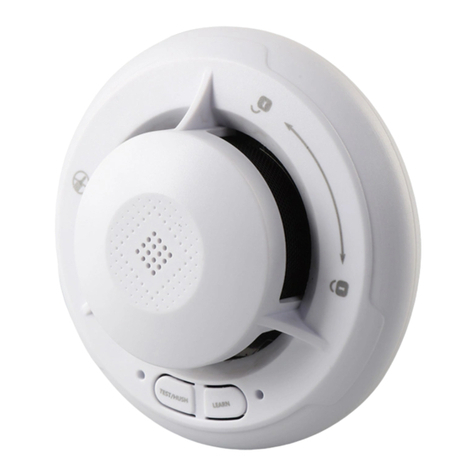
1.4.5 Alarm silence
When the detector is in alarm condition and the CO
concentration is less than 200 PPM, press and hold the TEST
button and it will enter alarm silence condition. Alarm silence
condition is the same as alarm condition except the buzzer
doesn’t beep temporarily. The Alarm indicator still flashes.
Alarm silence condition lasts less than 10 minutes. The higher
the CO concentration is, the shorter the alarm silence condition
lasts. When the alarm silence condition ends, and it will recover
alarm condition. You can also quit alarm condition by pressing
and holding the TEST button for 1 to 3 seconds. If CO
disappears, it will quit alarm silence condition automatically.
Make sure you are not in a dangerous situation before alarm
silence operation.
When the detector is in alarm condition, press and hold the
TEST button for 3 to 5 seconds until you see the Alarm indicator
flashes with no beep, then it will enter alarm silence condition. If
you press and hold the TEST button and still hear beeps, the
CO concentration may be more than 200 PPM. In this case, you
cannot silence the alarm.
When the detector is in alarm silence condition, press and hold
the TEST button until you hear beeps, then it will recover alarm
condition.
1.5 Fault warnings and handling
1.5.1 Sensor fault warning and handling
If there is fault in the sensor or circuit, fault warning will be given
within 3 minutes. Fault warning will be made at least once every
minute until the fault is eliminated.
When fault warning is given, there may be open circuit or short
circuit in the sensor. Or there may be electronic damage.
Volatile gas like ethyl alcohol may affect the sensor and cause
temporary fault. In this case, please replace the product with a
new one. Then power off the damaged unit and put it in clean
air for 24 hours, and it will return to normal.
If the unit can’t recover after being placed in clean air for 24
hours, that means permanent damage. Please don’t use the
product any more. Don’t repair it yourself or send to the
service point that is not authorized by the manufacturer.
1.5.2 Low battery warning and handling
When the detector is in normal operation, battery capacity is
checked every minute. When the voltage is less than 3.6V, low
battery warning will be given, the LCD display will show
condition D as specified in Section 1.3.1.4.
When low battery warning commences, batteries are only
capable of giving low battery warning for one month, or giving
alarm warning for a few minutes. So please replace the AA LR6
batteries as soon as possible.
W
hen you hear one beep every minute and see
condition D on the LCD display, please replace the LR6 AA
batteries immediately. O
therwise, the detector may not
work properly, which will threaten your health.
Warning:
When the alarm is damaged permanently, please stop
using it. Don’t repair it yourself or send to the service point
that is not authorized by the manufacturer.




























